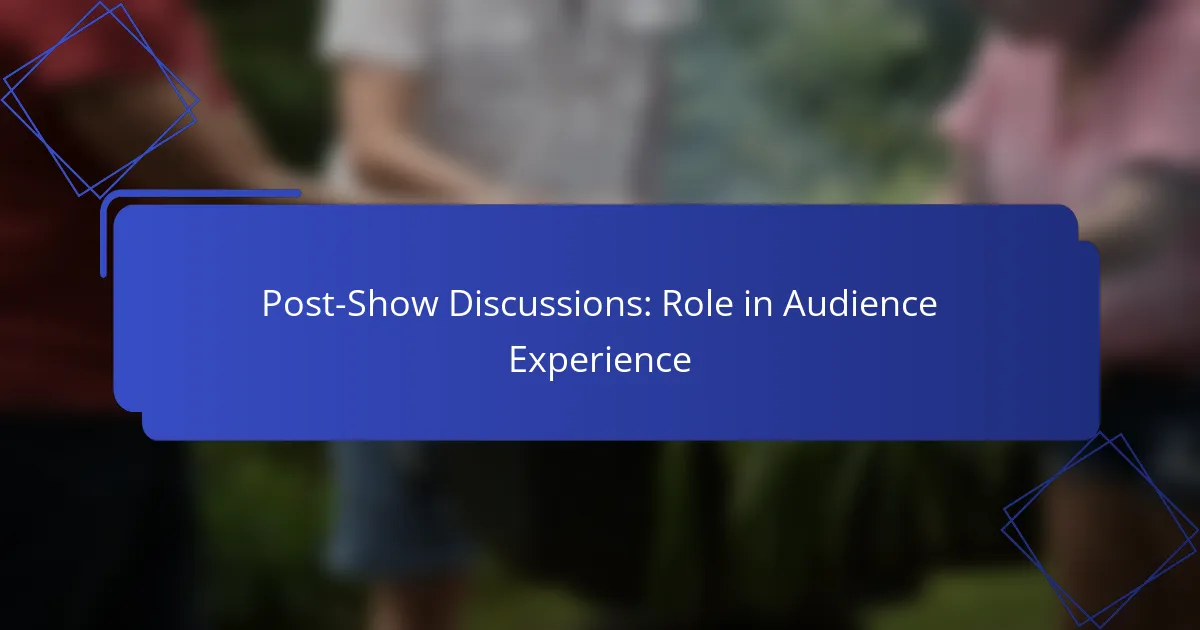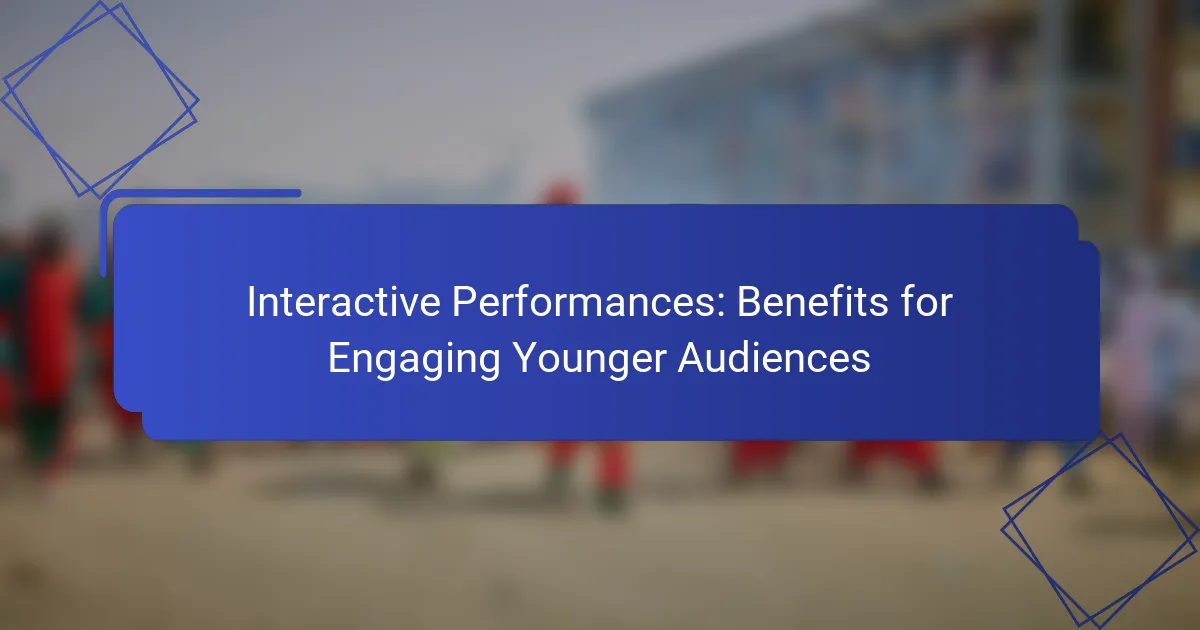Post-show discussions play a crucial role in enriching the audience experience by fostering reflection and dialogue. These interactions not only allow attendees to process their thoughts and share insights but also deepen their appreciation for the performance, enhancing their overall engagement with the content presented.
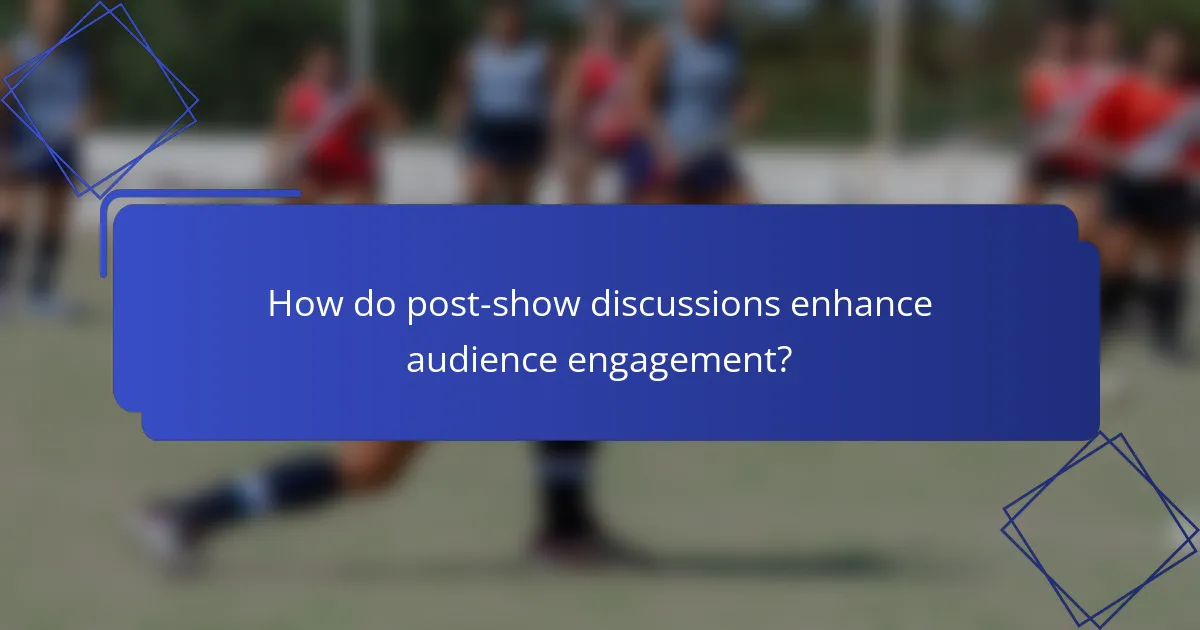
How do post-show discussions enhance audience engagement?
Post-show discussions significantly enhance audience engagement by providing a platform for reflection and dialogue. These interactions allow attendees to process their experiences, share insights, and connect with others, deepening their overall appreciation of the performance.
Facilitates deeper understanding
Post-show discussions promote a deeper understanding of the themes, characters, and messages presented in a performance. By engaging in conversation, audience members can explore different interpretations and gain insights that they may not have considered during the show.
For instance, a discussion following a complex drama can help clarify character motivations or thematic elements, enriching the audience’s comprehension. This deeper understanding can lead to a more fulfilling experience and encourage repeat attendance for similar events.
Encourages audience interaction
These discussions create opportunities for audience interaction, allowing attendees to voice their thoughts and feelings about the performance. Engaging with fellow audience members fosters a sense of belonging and can lead to lively debates and exchanges of ideas.
To maximize interaction, facilitators can pose open-ended questions or encourage participants to share personal connections to the performance. This approach not only enhances engagement but also makes the experience more memorable for everyone involved.
Builds community connections
Post-show discussions help build community connections by bringing together individuals with shared interests. These gatherings can strengthen bonds among attendees, creating a network of support and camaraderie that extends beyond the performance itself.
Local theaters can further enhance this sense of community by hosting regular discussion events, allowing audience members to reconnect and engage with one another. This practice not only enriches the audience experience but also fosters loyalty to the theater and its productions.
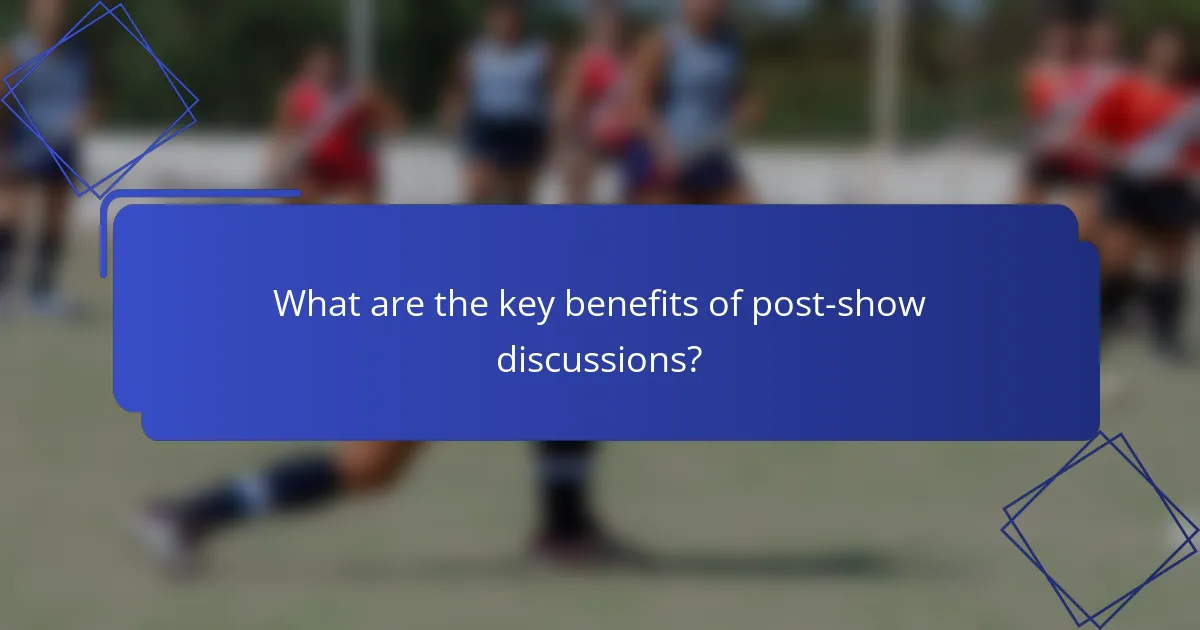
What are the key benefits of post-show discussions?
Post-show discussions enhance the audience experience by facilitating deeper engagement with the content presented. They allow attendees to reflect on key themes, clarify doubts, and connect with others, ultimately enriching their overall understanding and enjoyment of the event.
Improves retention of information
Post-show discussions significantly boost retention of information by allowing participants to process and articulate what they’ve learned. Engaging in dialogue helps reinforce key concepts, making it easier for attendees to remember details long after the event.
To maximize retention, encourage participants to summarize their takeaways or discuss specific elements of the show. This active involvement can lead to better recall and understanding of the material presented.
Provides networking opportunities
These discussions create valuable networking opportunities for attendees, enabling them to connect with like-minded individuals and industry professionals. Participants can exchange ideas, share experiences, and even explore potential collaborations.
To enhance networking, consider structuring discussions around specific topics or themes, which can help attendees find common ground and foster meaningful connections. Providing a relaxed environment can also encourage open dialogue.
Increases satisfaction with the event
Post-show discussions can lead to increased satisfaction among attendees by providing a platform for feedback and interaction. When participants feel heard and engaged, they are more likely to leave with a positive impression of the event.
To ensure satisfaction, facilitate discussions that allow for diverse viewpoints and encourage questions. Gathering feedback after these discussions can also help organizers improve future events and address any concerns raised by attendees.
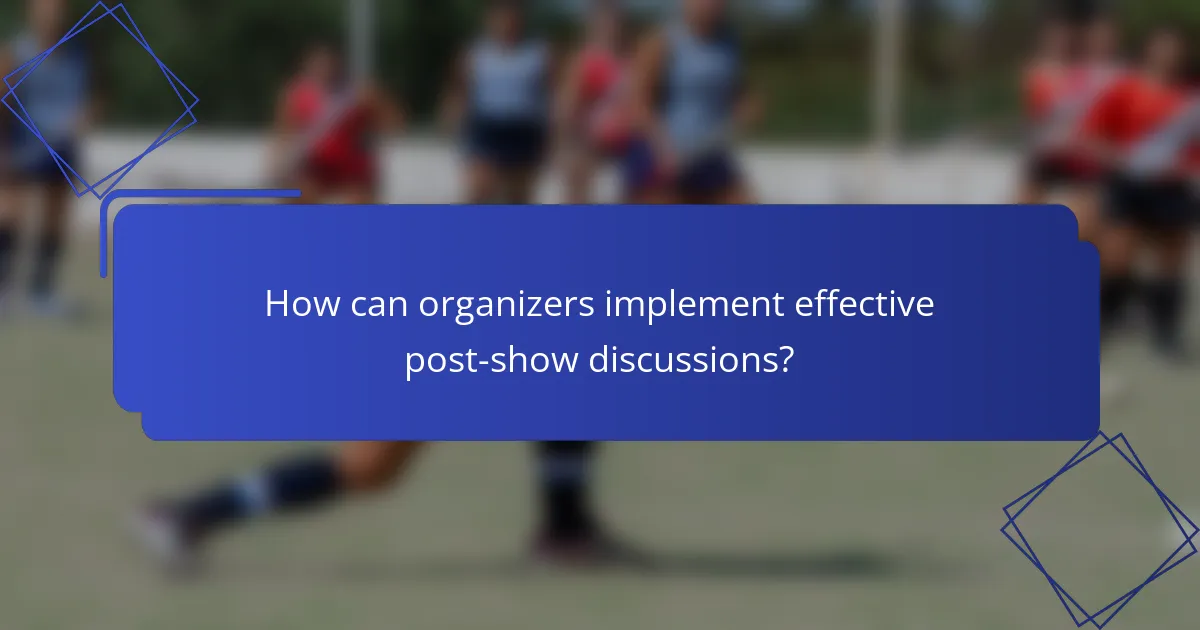
How can organizers implement effective post-show discussions?
Organizers can enhance audience experience by facilitating post-show discussions that encourage engagement and feedback. Effective implementation involves leveraging various platforms and formats to foster interaction and deepen understanding of the show’s themes.
Utilize social media platforms
Social media platforms are powerful tools for post-show discussions, allowing audiences to share their thoughts and connect with one another. Organizers can create dedicated hashtags or event pages to centralize conversations, making it easier for attendees to participate and follow along.
Encouraging audience members to post their reactions or questions can generate buzz and attract more viewers to future events. Consider hosting a live discussion on platforms like Twitter or Instagram to engage with fans in real-time.
Incorporate live Q&A sessions
Live Q&A sessions provide an interactive way for audiences to engage directly with performers or creators after a show. Organizers should schedule these sessions shortly after the performance to maintain momentum and interest.
Using video conferencing tools, such as Zoom or Facebook Live, allows for real-time interaction. Prepare a set of guiding questions to kick off the conversation, but also encourage spontaneous audience inquiries to create a dynamic dialogue.
Offer follow-up webinars
Follow-up webinars can deepen the audience’s understanding of the show’s content and themes. These sessions can feature discussions with cast members, directors, or subject matter experts who can provide additional insights.
Organizers should aim to schedule these webinars within a week or two after the show to keep the conversation fresh. Promote the webinars through email newsletters and social media to ensure maximum participation. Offering recorded sessions can also cater to those who cannot attend live.
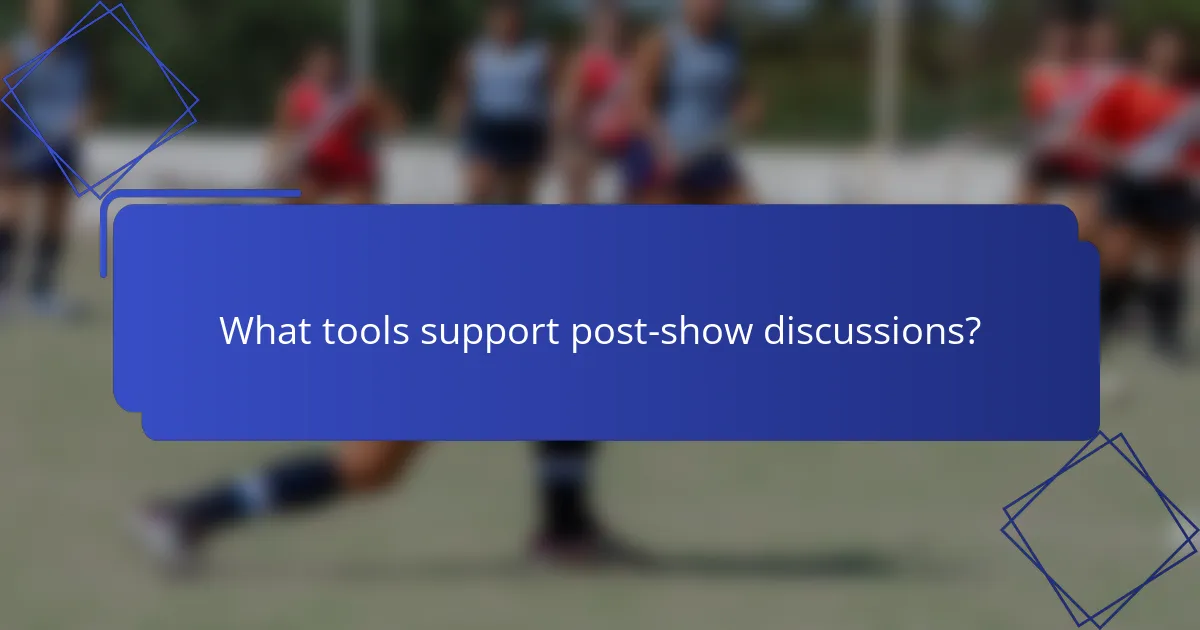
What tools support post-show discussions?
Post-show discussions can be effectively facilitated using various digital tools that enhance audience engagement and interaction. These platforms allow participants to share insights, ask questions, and build a sense of community after an event.
Zoom for virtual meetings
Zoom is a popular platform for hosting virtual meetings, making it ideal for post-show discussions. It allows participants to join from anywhere, facilitating real-time conversations and feedback. Consider scheduling a follow-up meeting shortly after the event to capture immediate reactions.
To maximize engagement, use features like breakout rooms for smaller group discussions or polls to gather audience opinions. Ensure that participants have the necessary links and access codes ahead of time to avoid technical issues.
Slack for ongoing conversations
Slack serves as an excellent tool for maintaining ongoing conversations after a show. By creating dedicated channels for specific topics, audiences can continue discussions at their own pace. This asynchronous communication allows participants to share thoughts and resources without the pressure of a live meeting.
Encourage users to post questions, share insights, or even upload related content. Regularly check in and engage with the community to keep the conversation lively and ensure everyone feels included.
Facebook Groups for community building
Facebook Groups provide a platform for building a community around your show. They allow for discussions, event updates, and sharing of multimedia content, fostering a sense of belonging among participants. Setting up a group can encourage attendees to connect and collaborate long after the event has ended.
To keep the group active, post regular updates, share highlights from the show, and encourage members to post their experiences. Consider hosting live Q&A sessions within the group to maintain engagement and attract new members.
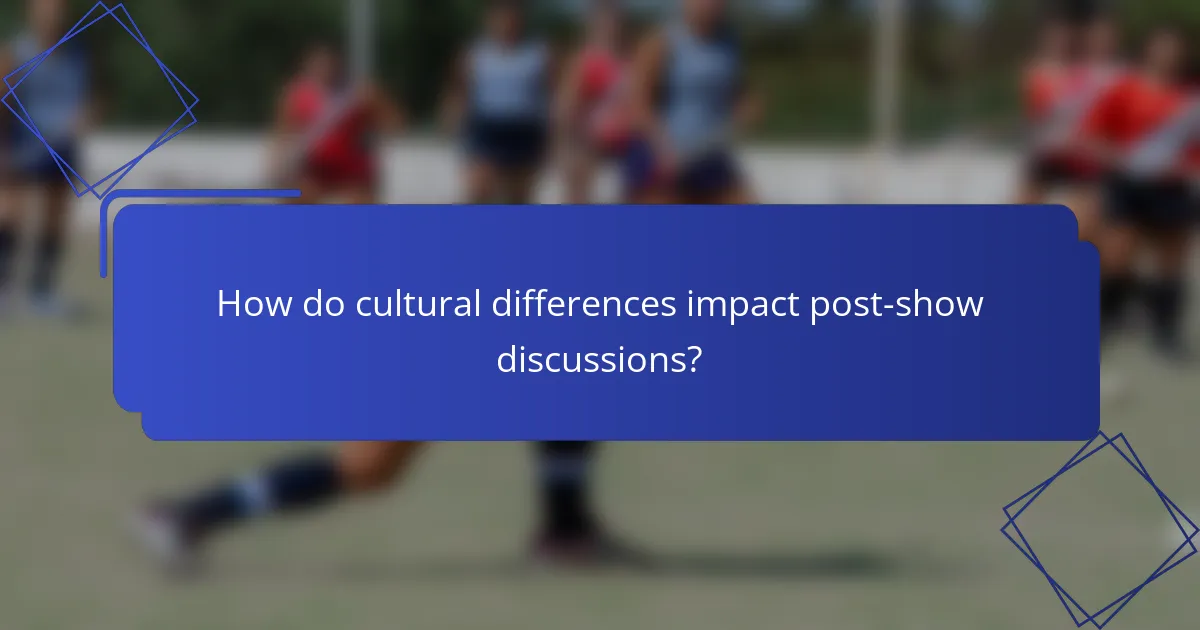
How do cultural differences impact post-show discussions?
Cultural differences significantly influence post-show discussions by shaping how audiences communicate and engage with each other. These variations can affect the depth of conversation, the topics discussed, and the overall audience experience.
Varied communication styles
Different cultures exhibit distinct communication styles that can impact post-show discussions. For instance, some cultures may prefer direct and concise dialogue, while others might favor a more elaborate and indirect approach. Understanding these styles can help participants navigate conversations more effectively.
In cultures where indirect communication is common, audience members may use non-verbal cues or context to express their thoughts. This can lead to misunderstandings if others are not attuned to these subtleties.
Different expectations for engagement
Expectations for audience engagement can vary widely across cultures. In some regions, audiences may anticipate lively debates and critical analysis, while in others, a more reserved and respectful discussion is the norm. Recognizing these differences can enhance the quality of interactions following a performance.
For example, in cultures that value collective harmony, individuals might be less likely to express dissenting opinions openly. This can result in a lack of critical feedback, which may be important for artists seeking to improve their work.
Influence of local customs
Local customs play a crucial role in shaping post-show discussions. Certain traditions may dictate how audiences interact after an event, including specific rituals or social norms that guide conversation. These customs can create a framework for how feedback is given and received.
For instance, in some cultures, it is customary to discuss the performance over a meal or drink, fostering a more relaxed atmosphere for sharing thoughts. In contrast, other cultures may prefer more formal settings for such discussions, impacting the tone and content of the conversation.

What are emerging trends in post-show discussions?
Emerging trends in post-show discussions focus on enhancing audience engagement and fostering deeper connections with the content. These discussions increasingly utilize digital platforms and social media to facilitate real-time interactions and broaden participation.
Increased Use of Digital Platforms
Digital platforms are becoming essential for post-show discussions, allowing audiences to engage from anywhere. Online forums, social media channels, and dedicated apps enable participants to share their thoughts and insights immediately after a show.
For example, platforms like Twitter and Instagram are often used for live discussions, where audiences can post reactions and questions using specific hashtags. This immediacy enhances the overall experience and allows for a broader range of voices to be heard.
Focus on Inclusivity and Diversity
Post-show discussions are increasingly prioritizing inclusivity and diversity, ensuring that various perspectives are represented. This trend encourages organizers to create spaces where all audience members feel comfortable sharing their views.
To achieve this, facilitators might implement guidelines that promote respectful dialogue and actively invite contributions from underrepresented groups. This approach not only enriches the conversation but also fosters a sense of community among participants.
Integration of Expert Insights
Integrating expert insights into post-show discussions is becoming more common, providing audiences with deeper context and understanding. Inviting industry professionals or scholars to participate can elevate the conversation and offer valuable perspectives.
For instance, after a theatrical performance, a director or actor might join the discussion to answer questions and share behind-the-scenes experiences. This interaction can significantly enhance audience appreciation and engagement with the material.
Hybrid Formats for Broader Reach
Hybrid formats that combine in-person and virtual discussions are gaining traction, allowing for greater accessibility. This approach enables audiences who cannot attend in person to participate through live streams or recorded sessions.
Organizers should consider offering both options to maximize engagement. For example, a live Q&A session could be held after a performance, with virtual attendees able to submit questions in real-time, ensuring everyone has a chance to contribute.
